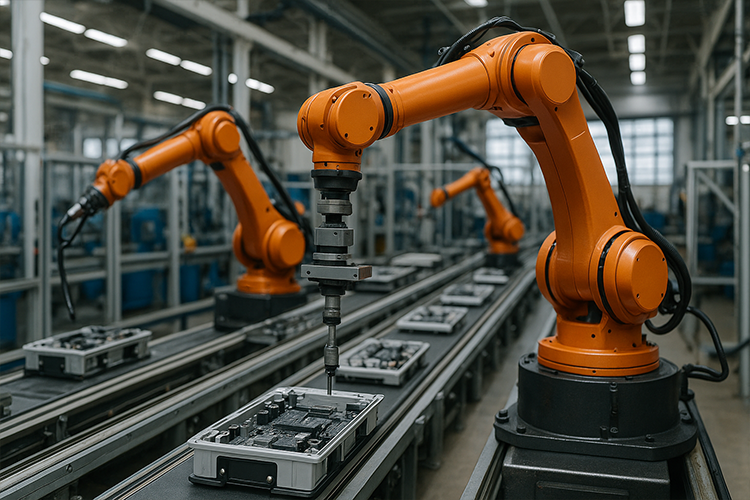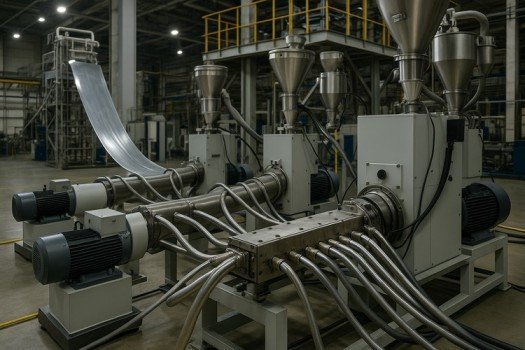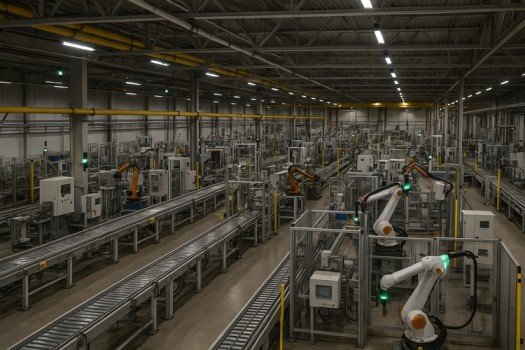The Core Principles
Every successful production line strategy builds on three foundational methodologies that have revolutionized manufacturing efficiency worldwide.
Lean Manufacturing Excellence
Lean Manufacturing eliminates waste while maximizing customer value through systematic identification of seven waste types: overproduction, waiting, transportation, inappropriate processing, excess inventory, unnecessary movement, and defects. Companies implementing Lean principles achieve 25-30% productivity improvements within their first year of implementation.
The methodology creates a continuous flow where products move seamlessly through production stages without interruption. Small manufacturers often benefit from a simplified production line strategy for a small business that focuses on flexibility and rapid market response rather than high-volume optimization.
Companies implementing Lean Manufacturing principles demonstrate measurable improvements in efficiency, quality, and cost reduction across their operations.
Six Sigma Quality Control
Six Sigma delivers near-perfect quality through statistical frameworks targeting 3.4 defects per million opportunities – achieving 99.9966% accuracy. Manufacturing facilities using Six Sigma report significant cost reduction in production lines through decreased rework and enhanced customer satisfaction.
The DMAIC methodology (Define, Measure, Analyze, Improve, Control) provides systematic problem-solving that addresses root causes. General Electric saved $12 billion over five years using Six Sigma across their manufacturing operations.
Data-driven decisions replace guesswork, creating predictable quality outcomes that reduce warranty costs and customer complaints.
Continuous Improvement Philosophy
Kaizen philosophy encourages small, incremental changes that compound into substantial operational gains. This approach engages every employee in identifying improvement opportunities, creating ownership where manufacturing efficiency becomes everyone’s responsibility.
Regular improvement cycles prevent operational stagnation while ensuring your systems evolve with market demands and technological advances. Companies practicing Kaizen report sustained productivity improvements through employee-driven innovations and continuous process optimization.
Step-by-Step Implementation
Building an effective production line strategy requires methodical planning and execution across four critical phases.
Phase 1: Current State Analysis
Map existing workflows to identify inefficiencies and bottleneck analysis opportunities. Document every process from raw material receipt to finished product shipping, measuring cycle times and identifying constraint points.
This baseline assessment reveals where implementing automation in a production line delivers maximum returns. Most manufacturers discover that 20% of their processes consume 80% of resources – these become priority optimization targets.
Use value stream mapping to visualize material and information flow, highlighting non-value-added activities that increase costs without benefiting customers.
Phase 2: Production Line Layout Design and Optimization
Design physical spaces that minimize material movement and reduce cycle times through strategic positioning. Optimal layouts follow linear flow principles, eliminate backtracking, and position quality checkpoints at critical control points.
Consider how to improve production line efficiency by organizing workstations according to process sequence rather than departmental convenience. Successful redesigns reduce material handling costs by 15-25% while improving worker productivity through ergonomic positioning.
Calculate walking distances, material movement frequency, and changeover requirements when determining equipment placement and workflow patterns.
Phase 3: Technology Integration Planning
Select technologies that solve specific operational problems rather than implementing solutions by searching for applications. ERP software integration provides real-time visibility into production schedules, inventory levels, and quality metrics across all manufacturing operations.
IoT sensors enable predictive maintenance and performance monitoring that prevents unexpected downtime. Strategic technology adoption supports your operational strategy without adding unnecessary complexity to proven processes.
A comprehensive production line strategy integrates these technological capabilities to create smart manufacturing systems that respond dynamically to changing demands.
Phase 4: Best Practices for Production Line Management
Establish standard operating procedures ensuring consistency across shifts and operators. These standards must cover setup procedures, quality checkpoints, maintenance schedules, and performance measurement protocols.
Training programs emphasize both technical competencies and continuous improvement mindsets. Effective management systems create accountability while empowering workers to identify problems and implement solutions independently.
Document procedures clearly, measure adherence regularly, and update standards based on improvement discoveries and changing requirements.
The Role of Technology
Technology transforms traditional manufacturing into responsive, intelligent production systems that adapt to market demands.
Automation and Robotics Integration
Factory automation augments human capabilities rather than replacing workers entirely. Research shows that over 80% of companies have adopted or plan to adopt automation for end-of-line activities like palletizing and material handling. Robotics excels at repetitive tasks requiring exact positioning and consistent timing, while humans handle complex decision-making and quality judgment calls.
Strategic automation targets high-volume processes with consistent specifications and safety concerns. Return on investment typically occurs within 18-24 months for properly selected applications, with labor cost reductions of 20-35%.
Collaborative robots work alongside humans, combining machine precision with human flexibility and problem-solving capabilities.
Supply Chain Management Systems
Just-in-Time (JIT) manufacturing requires sophisticated coordination between suppliers, production schedules, and customer demands. Recent challenges have prompted manufacturers to prioritize resilience, with 86.2% of companies working to de-risk their supply chains over the past two years. Modern supply chain management systems provide the visibility and coordination necessary for minimizing inventory while ensuring material availability.
These systems reduce working capital requirements by 20-40% while improving delivery performance through enhanced demand forecasting and supplier coordination. Real-time data sharing prevents stockouts and reduces emergency expediting costs.
Integration with supplier systems creates seamless material flow that responds automatically to production schedule changes and demand fluctuations.
Quality Control Technologies
Advanced quality control systems use machine vision, statistical process control, and automated testing to ensure consistent product quality. These technologies identify defects earlier in processes, reducing scrap costs and improving customer satisfaction rates.
Real-time quality monitoring enables immediate corrections that prevent defective products from reaching customers. Automated inspection systems process 100% of production versus traditional sampling methods that miss defects.
Digital quality records provide traceability and enable rapid root cause analysis when issues occur downstream.
Measuring Your Success
Tracking critical metrics ensures your production line strategy delivers measurable business results through systematic performance monitoring.
Key Performance Indicators
Monitor Overall Equipment Effectiveness (OEE), cycle time, throughput, first-pass yield, and cost per unit to gauge operational excellence. OEE combines availability, performance, and quality into a single metric reflecting true productivity levels.
World-class manufacturers achieve OEE rates above 85%, while average performers operate at 60-70% effectiveness. Each percentage point improvement in OEE typically translates to a 1-2% increase in profitability.
Track these metrics hourly during production to identify trends before they become problems requiring expensive corrective actions.
Process Optimization Metrics
Monitor workflow management efficiency through lead times, setup times, and changeover frequency. These measurements reveal additional improvement opportunities and validate the implemented change effectiveness.
Setup time reductions of 50% or more are achievable through SMED (Single Minute Exchange of Dies) techniques. Shorter changeovers enable smaller batch sizes and improved responsiveness to customer demands.
Regular metric reviews identify performance trends, enabling proactive management rather than reactive firefighting when problems escalate.
Challenges in Production Line Optimization
Common obstacles include change resistance, insufficient training, inadequate measurement systems, and poor interdepartmental communication. Address these challenges through clear communication, comprehensive training programs, and visible leadership commitment to improvement initiatives.
The tools for production line management must align with organizational culture and technical capabilities to ensure successful adoption. Start with simple improvements that demonstrate value before implementing complex solutions.
Change management becomes critical when disrupting established workflows – involve affected employees in solution design to reduce resistance.
Conclusion
Well-designed production line strategy transforms manufacturing operations from reactive firefighting into proactive optimization systems. Combining Lean principles, Six Sigma quality standards, and a continuous improvement culture creates sustainable competitive advantages that compound over time.
Success requires commitment to systematic implementation, employee engagement, and consistent result measurement. Start with a thorough current state analysis, design optimal layouts, integrate appropriate technologies, and establish robust measurement systems.
Companies thriving in competitive manufacturing markets view their production line strategy as a dynamic system requiring constant refinement and improvement. PlentifulChoices specializes in helping manufacturers develop and implement comprehensive strategies for sustainable growth.
Your next step involves conducting a thorough assessment of current operations to identify the highest-impact improvement opportunities. Whether you need a complete production line setup or targeted optimization of existing processes, professional industrial services can accelerate your journey toward manufacturing excellence.
FAQs
A production line strategy is a comprehensive framework that organizes manufacturing processes to maximize efficiency, minimize waste, and ensure consistent quality. It’s essential because it transforms chaotic operations into systematic workflows that reduce costs, improve delivery times, and maintain competitive advantages in demanding markets.
Without structured approaches, manufacturers lose 15-20% of potential productivity to preventable inefficiencies while struggling to meet customer expectations for quality and delivery.
Optimize your production line by implementing Lean Manufacturing principles, eliminating bottlenecks through systematic analysis, and integrating appropriate automation technologies. Focus on continuous flow, reduce setup times, and position quality checkpoints to prevent defects from progressing through systems.
Start with value stream mapping to identify constraints, then apply focused improvements to bottleneck operations. Most manufacturers achieve 20-30% output increases within the first year.
Critical KPIs include Overall Equipment Effectiveness (OEE), cycle time, throughput, first-pass yield, and cost per unit. These metrics provide comprehensive visibility into productivity, quality, and efficiency, enabling data-driven decisions that improve operational performance.
OEE above 85% indicates world-class performance, while scores below 60% suggest significant improvement opportunities. Track these metrics hourly to identify trends before they become problems
Automation enhances human capabilities by handling repetitive tasks with precision and consistency while freeing workers for complex decision-making and quality judgment. Strategic automation focuses on high-volume processes with consistent specifications, typically delivering ROI within 18-24 months.
Successful automation targets 20-35% labor cost reductions while improving quality consistency and reducing workplace safety risks through the elimination of hazardous manual operations.
Lean Manufacturing focuses on eliminating waste and creating continuous flow, while Six Sigma emphasizes statistical quality control to achieve near-perfect defect rates. Lean optimizes speed and efficiency, whereas Six Sigma targets precision and consistency through data-driven problem-solving methodologies.
Many manufacturers combine both approaches – using Lean to improve flow and reduce waste, then applying Six Sigma to eliminate quality defects and process variation.









